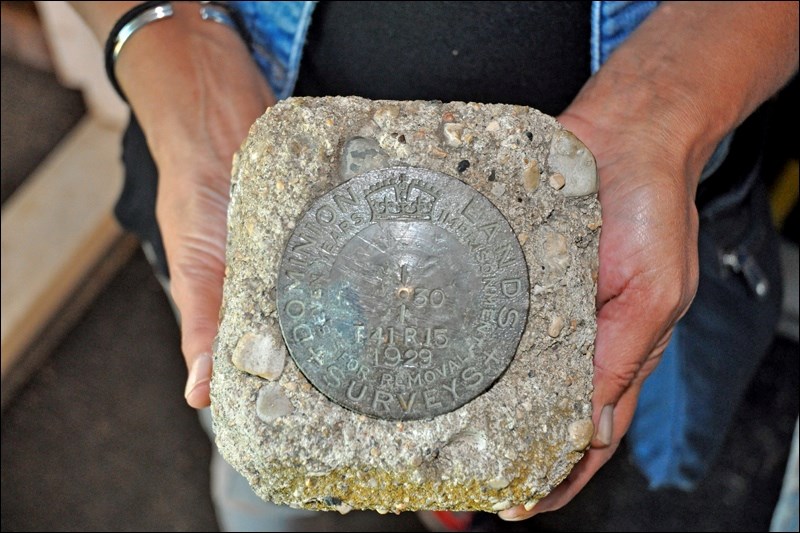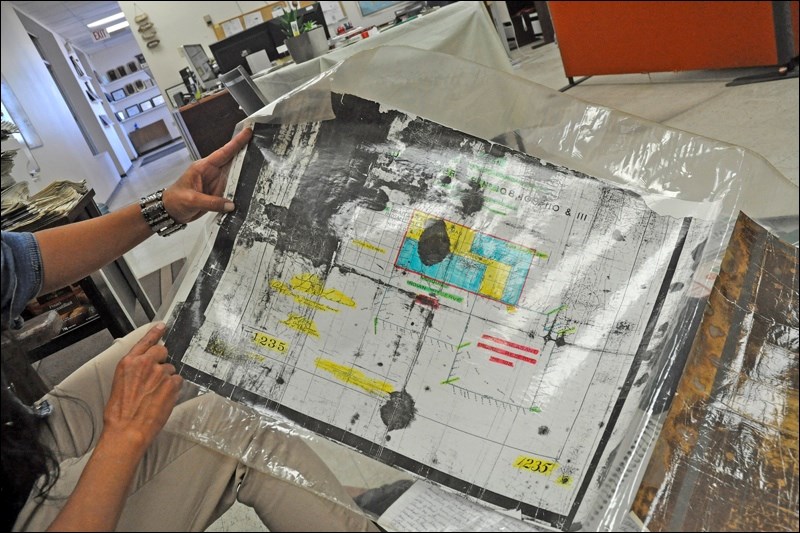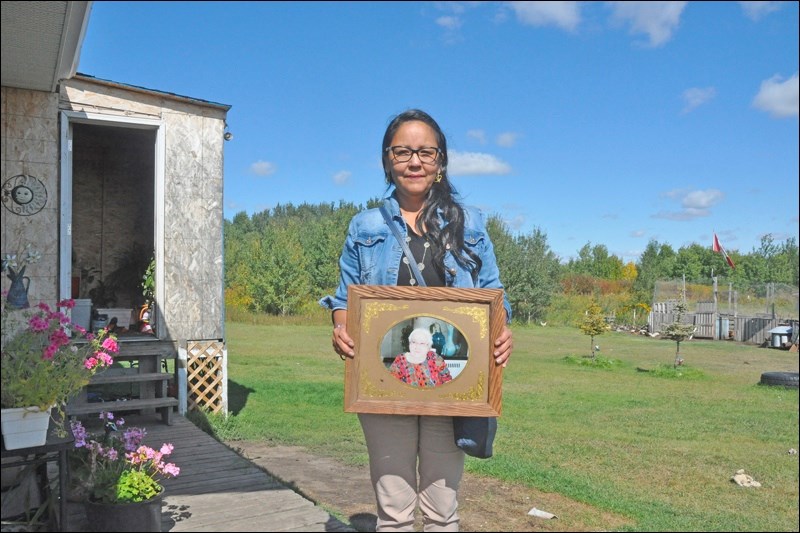Christine Wahobin loved her grandmother, but the relationship wasn’t typical.
Mary Wahoben, who passed away in 2008, was hereditary chief of Lean Man band, one part of Mosquito-Grizzly Bear’s Head-Lean Man First Nation. The First Nation is located south of Battleford and intersects Highway 4.
After her grandmother’s death, Christine Wahobin assumed the responsibilities as Lean Man’s hereditary chief.
Hereditary chiefs have responsibilities to their people, and the people often regard hereditary chiefs highly. Today, however, not many people treat Wahobin in that manner.
Wahobin lives on the Mosquito-Grizzly Bear’s Head-Lean Man First Nation land, but her house lacks heating. Her long driveway isn’t always ploughed in the winter and she sometimes has to walk through snow to get to her house.
She has noticed fences erected close to her land without her consent. She keeps chickens and would like goats or sheep, but doesn’t have the space for them.
Wahobin said honouring the treaties is an important part of her role as hereditary chief.
“Today is nothing without the treaties,” Wahobin told the News-Optimist recently. “Those treaties are more important to me than anything else.”
Mosquito-Grizzly Bear’s Head-Lean Man is distinctive because it includes three bands under Treaty 4 and Treaty 6. Band members are Cree, Assiniboine and Nakoda.
Wahobin doesn’t consent to the combined First Nation, and she feels Lean Man is marginalized within the reserve. Some connected to Lean Man support Wahobin, she said, but don’t speak out due to fear of being blacklisted on the reserve.
Wahobin also doubts treaties can be combined.
Mosquito-Grizzly Bear’s Head-Lean Man First Nation is made of three sections of land: Mosquito is Indian reserve No. 109, Grizzly Bear’s Head is No. 110, and Lean Man is No. 111.
According to Indigenous Saskatchewan Encyclopedia, Mosquito band settled on the reserve in 1879-80 under Treaty 6. Lean Man executed an adhesion to Treaty 4 in 1877 and came from the Fort Qu’Appelle-area, but migrated to the Battleford area.
Disease was present at the time and devastated populations, Wahobin said. Lean Man band was starving and was chased to Treaty 6 territory.
“Grandpa said to me one time, he didn’t want to run anymore. He said ‘if they’re going to kill us, they’ll kill us all here,’” Wahobin said.
Calgary-based lawyer Ron Maurice, hired by the First Nation, has researched the First Nation’s formation. In 2014, he filed a declaration of claim against the federal government, arguing the government acted unlawfully over the years.
In 1884, Indian Affairs surveyed Indian reserves 110 and 111, a total area of more than 23,000 acres.

According to an 1884 Department of Indian Affairs report, the three bands “performed a great deal [of] work, and made good progress in agriculture.”
The North West Rebellion took place in 1885, and the federal government introduced punishments for bands the government deemed to be disloyal.
Such disloyalty came into question more than 100 years later when bands claimed the government had illegally withheld money from them.
Mosquito-Grizzly Bear’s Head-Lean Man was awarded close to $6 million in 2018, due to adding compound interest over the years to the withheld funds.
Between 1896 and 1911, several surrenders of reserve land took place in Saskatchewan. Many surrenders were suspected, according to a 1998 report, to have been unlawful.
1905 was an important year for Saskatchewan, as the province was formed. 1905 was devastating for Lean Man, in that the band surrendered part of its land. The surrender, however, is disputed.
Wahobin said Lean Man land was at one time considered too rocky or hilly for farming. But people became interested in the land.
According to Wahobin citing oral history, a “red coat” (representative of the federal government) came to the reserve and spoke to the people.
The people of Lean Man, Wahobin said, spoke Assiniboine but not English. Wahobin said the people were starving, dying and felt threatened. Payments were offered in return for surrendered land.
In 1905, “Indians of the three Stony bands” requested a land surrender, according to Maurice’s claim. But Indian agent J.P.G. Day wrote the three bands “are to all intents and purposes one band.”
The issue of Mosquito-Grizzly Bear’s Head Lean Man being one band or three was an important historical question in 1905.
Maurice wrote Agent Day misrepresented that members of the three bands lived together and, “if the surrender were approved, they would all live together on the Mosquito reserve.” Maurice argued the representation of the three bands as one was a breach of fiduciary duty by the federal government.
Also, Maurice wrote, “the majority of the people present at the [1905] meeting, and who purportedly voted on the surrender, were members of the Mosquito band who were not ordinarily resident or interested in IRs 110/111.”
A total of 14,400 acres, much of which was Grizzly Bear’s Head and Lean Man, was purportedly surrendered by the “Stony Band” to the Crown.
Wahobin has written and video testimony of her grandmother Mary Wahoben doubting the legitimacy of the land surrender.
Lean Man’s agreement, according to Wahobin, was the Lean Man land in question would be borrowed for 99 years. Payments were promised, she said, and Lean Man wanted money to go to his grandchildren.
“When you’re done with my land, you give that payment to my grandchildren,” Wahobin said referring to oral history. “And you give them back that reserve so they can go home.”
The payments caused trouble for Lean Man.
According to Maurice’s submission, the surrender agreement stipulated that the Crown was to hold money for the land sale and pay members of the Grizzly Bear’s Head and Lean Man bands and their descendants.
However, Mosquito band was also paid for land sales of Grizzly Bear’s Head and Lean Man, Maurice claimed.
The name Tibiyohi of Lean Man appears on the 1905 surrender, according to Maurice’s claim. Tibiyohi was Lean Man’s son, and Mary Wahoben’s grandfather.
The 1906 Indian Affairs annual report states the band membership of Lean Man was one.
Christine Wahobin, along with Maurice’s submission, reject the legitimacy of the surrender. Maurice claimed Grizzly Bear’s Head and Lean Man bands didn’t fully understand what they were doing.
Maurice also claimed federal government officials were involved in a corrupt scheme to sell reserve land. Indian Affairs officials instructed a Dominion land surveyor to subdivide 110 and 111 as early as 1903, two years before the bands asked for the surrender, according to the claim.
The Crown’s 2014 response to Maurice’s claims agreed upon some facts, but rejected most of Maurice’s other claims.
But in 2017, according to a fact sheet Maurice provided to band members at a recent band meeting, “Canada agreed to admit liability for its breach of its pre-surrender fiduciary duty.”
The 1905 land surrender is a high stakes legal case. After the Crown’s admission, Maurice suggested Canada settle the claim for $145 million. Canada never replied to Maurice Law’s settlement proposal.
Maurice Law recommended chief and council proceed to trial on the issue of compensation.
After 1905, times continued to be tough for the Lean Man band.
In 1935, Wahobin said according to oral history, red coats killed Tibiyohi with an axe. Wahobin said her ancestor didn’t want to give up more land. As Wahobin sees it, Mosquito band betrayed her relative. Mary Wahoben had suspicions of Mosquito’s first chief Misketo.
Meanwhile, whether or not the bands were a single entity or not became important again in 1949.
At different times, the department considered the three bands to be three, and at other times to be one entity.
In a 2001 court submission, lawyer James D. Jodouin wrote the three bands being considered one was in the best interest of the Department of Indian Affairs as “there would have been problems with the intermingling of trust funds from the sale of the purportedly surrendered land.”
According to one Indian Affairs official in 1949, if Grizzly Bear’s Head and Lean Man bands used and occupied 109, it was fair that Mosquito share the proceeds of the sale of the surrounded portions of 110 and 111.
In 1949, according to the Crown’s response to Maurice, the three bands were amalgamated.
The fact they needed to be amalgamated at all, for Jodouin, meant they were three separate bands beforehand. But Jodouin raised doubts even about the 1949 amalgamation process, arguing the vote hadn’t followed the Indian Act.
A pattern repeated. Mosquito band members, again, represented a majority on an important question that required consent from minority populations within the reserve, according to Jodouin.
There was animosity among some band members at the time, according to Jodouin, regarding the amalgamation and the surrender.
Lean Man’s population was nearly depleted. An Indian Affairs official, writing to Ottawa in 1949, wanted to change the First Nation’s name.
“As there are no survivors of the Lean Man band, I would also suggest that the name Lean Man be dropped and the land included in the area designated as Mosquito-Grizzly Bear’s Head reserve.”
“This would then eliminate any possibility of a future argument of this nature,” he wrote.
The argument wasn’t eliminated, nor was Lean Man band, as Mary Wahoben was alive. According to Christine Wahobin, the 1949 amalgamation was fraudulent.
Wahobin said Lean Man band hasn’t received much benefit from the 99-year agreement, nor from the administrative structure of Mosquito-Grizzly Bear’s Head-Lean Man, which she said doesn’t properly compensate people connected to the band. Those connected to Lean Man are rarely elected to chief and council roles, even though chief and council make important decisions about Lean Man.
Farmers work Lean Man land, but Wahobin said she doesn’t receive money from it.

The News-Optimist sent Mosquito-Grizzly Bear’s Head-Lean Man First Nation questions regarding allegations of discrimination against Lean Man but didn’t receive a response.
Wahobin also said she didn’t trust the First Nation’s leadership.
In 2010, Eldon Starchief and Alphonse Moosomin pled guilty to fraud regarding a sum of treaty land entitlement money. Chiefs have been removed due to vote buying and have been suspended from running for office.
The First Nation’s new chief and council have pledged to have more transparency, accountability, and to further economic interests. Recently, the First Nation announced they would start a construction company and a security company.
Some of the new leadership’s decisions have attracted support online.
Regarding the First Nation’s economic endeavours, Wahobin said “if they have the money to do it, by all means, go ahead, that’s a good thing. There’s nothing wrong with it because you’re creating jobs and futures for your people.”
But Wahobin doesn’t want to be involved with Mosquito.
“I’ve got my own claim, I’ve got my own reserve, I’ve got my own people,” she said.
An attitude in the past expressed hostility toward bands separating.
In a quote attributed to Chief Jim Spyglass, Councillor Joe Wahobin and Councillor Adam Mosquito from the BATC website, chief and council “declared that the three bands remain together for all time. If any band member wished to distinguish the band and separate the bands then that person and his family should leave the band altogether.”
Wahobin seeks entitlements for Lean Man under Treaty 4, including land. She added she’d be content with reserve land for Lean Man away from where Lean Man is now.
As a start, Wahobin said she’d like money to travel to Treaty 4 meetings, as other chiefs receive.
She also said she’s spoken to a lawyer who wants $5,000 and who would “take Mosquito to court,” Wahobin said. She said she’d like Perry Bellegarde, National Chief of the Assembly of First Nations, to look into the Lean Man matter.
Indian Affairs has not only had an effect on physical boundaries of the reserves and the band’s administration, but also on Wahobin’s last name.
In a written document, Mary Wahoben said the family’s last name was supposed to be Leanman after the reserve.
“Why was Wahobin used when the name came from Mosquito?” Wahoben asked. “A few times we got treaty for the name Wahobin so therefore Indian Affairs wrote us [as] Wahobins.”
“They had tried hard to mislead us so they went ahead and did whatever they wanted to do at that time.”
In the meantime, Wahobin drives her children to school in Battleford rather than take them to the reserve school.
One day, Wahobin said, she’d like to make her son hereditary chief of Lean Man.



